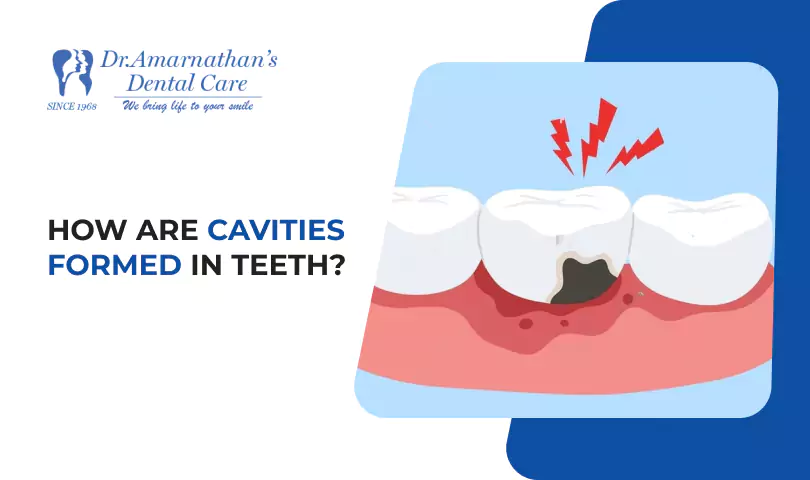
How are cavities formed in teeth?
Cavities in teeth, commonly known as dental caries, are among the most frequent oral health issues globally. They result from the slow deterioration of tooth enamel, the hard outer surface of your teeth. Understanding how cavities occur might help you prevent them and maintain good dental health. In this blog, we will look at the process of cavity creation, the elements that contribute to it, and how to prevent them.
What Are Cavities?
Cavities are irreversible damage to your teeth that can cause tiny gaps in the enamel. If left untreated, cavities can spread further into the tooth, impacting the dentin and pulp and potentially causing discomfort, infection, and tooth loss.
How Do Cavities Form?
The creation of cavities in teeth begins with germs that naturally exist in the mouth. When humans ingest sugar and carbohydrate-rich meals and beverages, these bacteria feed on the sugars and make acids as byproducts. These acids, together with other bacterial activities, create a sticky coating on the teeth known as plaque.
Plaque adheres to the surface of the teeth and reacts with food particles, producing additional acid. This acid gradually erodes the enamel, resulting in the creation of cavities.
Stage 1: Plaque Formation
Plaque is a soft, sticky biofilm that continuously grows on teeth. It is made up of microorganisms, saliva, food particles, and acids. Plaque develops after eating or drinking, particularly sugary or starchy meals. Without regular dental hygiene, it hardens into tartar, which is more difficult to remove and speeds up the decay process.
Stage 2: Acid Attack
Once plaque develops, the bacteria within it begin to feed on carbs and sugars. As bacteria eat these sugars, they produce acids as a byproduct. These acids degrade the minerals in tooth enamel, a process known as demineralization.
Enamel is the most challenging component in the human body, although it is not resistant to acids. As the acids continue to assault, the enamel eventually deteriorates and loses structure. This is the early stage of cavity creation.
Stage 3: Enamel Decay
As the enamel erodes, tiny holes appear on the tooth surface. These little patches of demineralization represent the first phases of cavity development. If left untreated, the damage progresses further into the tooth, from the enamel to the dentin layer underneath.
Dentin is weaker and more susceptible to deterioration than enamel; therefore, the cavity spreads faster once it reaches this stage. This is when a person may begin to experience sensitivity to hot, cold, or sweet meals.
Stage 4: Dentin and Pulp Involvement
If the cavity continues to grow, it will ultimately reach the pulp, the interior portion of the tooth that houses nerves and blood vessels. When the pulp becomes infected, it can cause severe pain, abscess development, and ultimately the need for root canal therapy or tooth extraction.

What Causes Cavities in Teeth?
A number of factors contribute to the creation of cavities in teeth, including:
- Consuming sugary and starchy foods such as candy, soda, bread, and chips feeds bacteria that produce tooth-damaging acids.
- Inconsistent brushing and flossing lead to plaque buildup, increasing the risk of cavities.
- A lack of saliva (xerostomia) lowers food particle clearance and acid neutralization, which increases the risk of cavities.
- Drinks such as soda, fruit juice, and alcohol increase acid levels, eroding tooth enamel.
- Constant munching feeds bacteria, resulting in continuous acid generation.
- Teeth with deep grooves and pits collect food and germs, increasing their susceptibility to decay.
How to Prevent Cavities in Teeth?
Understanding how cavities in teeth occur is the first step towards avoiding them. Here are some preventative practices to keep teeth strong and healthy:
Brush and floss regularly: Brush your teeth twice a day with fluoride toothpaste and floss regularly to eliminate plaque and food particles from between your teeth.
Use fluoride: Fluoride strengthens tooth enamel and reverses the early stages of tooth decay. It can be found in toothpaste, mouthwash, and even tap water in some areas. Your dentist may also suggest fluoride treatments to provide further protection.
Limit sugary and acidic foods: Cut back on sugary foods, drinks, and acidic liquids. Choose healthier choices, such as fruits, vegetables, and water.
Drink plenty of water: Staying hydrated promotes saliva production, which naturally cleanses and neutralizes acids.
Regular dental checkups: Schedule frequent checkups and cleanings with your dentist. Professional cleanings assist in eliminating tartar and plaque buildup, whereas your dentist may detect early symptoms of decay and offer treatments such as sealants or fluoride applications.
Consider dental sealants: Dental sealants are thin coatings applied to the chewing surfaces of the molars. They protect the enamel against plaque and acids, which is especially important in children and people who are more prone to cavities.
The Importance of Early Detection
Cavities in teeth can cause pain and suffering if not addressed, but early discovery can help avoid additional harm. Regular dental appointments help your dentist detect cavities early when the damage is generally reversible or preventable with minimum treatment.
Treatments for Cavities in Teeth
Once a cavity has formed, therapy will be determined by its severity:
Fluoride Treatment: Fluoride treatments can help rebuild enamel and reverse decay in the early stages of a cavity.
Fillings: If a cavity has developed beyond the enamel, your dentist will remove the decaying material and replace the area with a filling material such as composite resin, amalgam, or porcelain.
Crowns: In situations of severe decay, a dental crown may be required to cover and protect the affected tooth.
Root canals: If the decay progresses to the tooth pulp, a root canal may be necessary to remove the affected tissue and preserve the tooth.
Extractions: In extreme circumstances, if the tooth cannot be saved, it may have to be removed.

Conclusion
Cavities in teeth arise when bacteria in the mouth react with sugars and carbohydrates, releasing acids that erode tooth enamel. If left unchecked, this process might eventually cause substantial tooth damage. However, by practicing excellent dental hygiene, limiting sugary and acidic meals, and going to the dentist on a regular basis, you may successfully prevent cavities and keep your smile healthy.
Remember that understanding how cavities in teeth arise is essential in preventing them from becoming a bigger problem. Maintain a proactive dental care practice to keep your teeth healthy and cavity-free!




